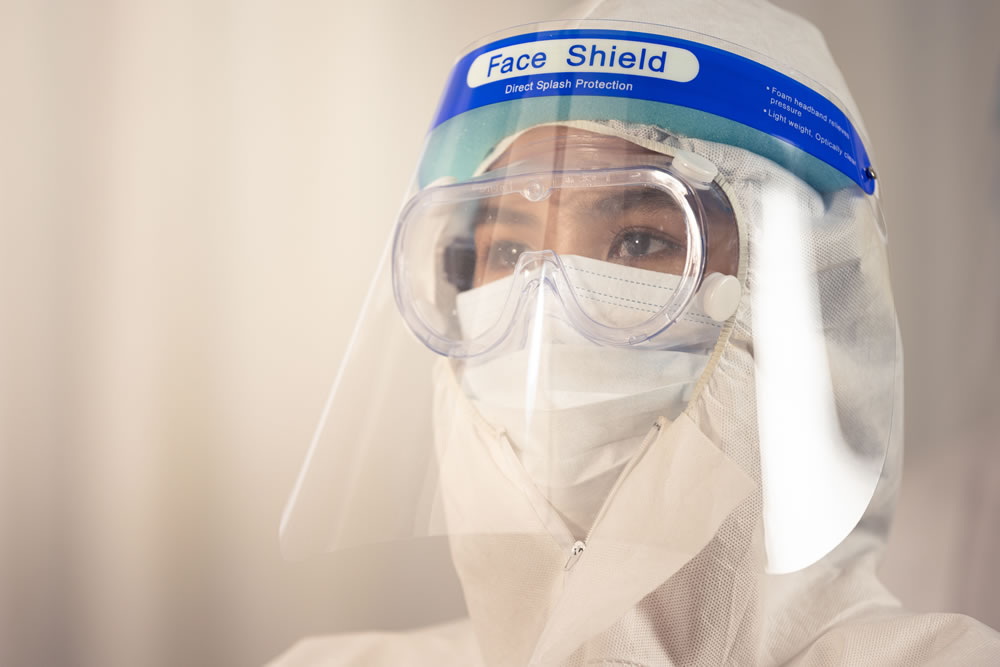This is the final part of a six-part series on lessons learned from the COVID-19 pandemic, inspired by a conversation with Interim Physicians Medical Director Ken Teufel, MD.
Lesson #6: We Must Be Prepared for Health Crises. Locum Tenens Could Fit Crisis Staffing Plans.
Maintaining stockpiles of personal protective equipment (PPE) and viable, life-saving medical equipment, like ventilators and respirators, is critical for both healthcare providers and governments.

When the coronavirus pandemic hit the US in March, both the federal government and many states and cities found their emergency stockpiles of these items depleted. As emergency departments and ICUs–particularly in large urban centers like New York City–filled to and beyond capacity with patients fighting COVID-19, hospitals struggled to protect their workers and to access enough ventilators and other equipment needed to treat large volumes of critically ill patients.
Now, a couple of months after most states locked down during the pandemic’s initial phase began opening–and with the Trump Administration having tested approximately 15 percent of the US population (fourth-most in the world among countries most severely affected by the pandemic), we’ve seen another surge in the numbers of positive COVID-19 cases, hospitalizations and deaths across the US. (The US had conducted almost 50 million coronavirus tests as of July 24, 2020.)
“Experts say these outbreaks are largely driven by people flocking to newly reopened restaurants, bars, gyms, and other high-risk indoor spaces, as well as weakly enforced or nonexistent face mask mandates,” according to a July 16 Vox article. “Now, with new cases and hospitalizations rising in 44 US states and territories, many fear some hot spots may be faced with even bigger surges, with less ability to expand capacity than hospital-dense New York City.”
As of this writing, the number of US cases has topped four million–just two weeks after exceeding the three-million mark. As of July 24, the US COVID Tracking Project at The Atlantic reported nearly 60,000 hospitalizations and 136,477 deaths; the US death toll had exceeded 140,000 as of July 23, according to the Boston Globe.
PPE Runs Low (Again)
“The personal protective gear that was in dangerously short supply during the early weeks of the coronavirus crisis in the U.S. is running low again as the virus resumes its rapid spread and the number of hospitalized patients climbs,” according to a July 7 story by the Associated Press (AP). A national nursing union is concerned that gear has to be reused. A doctors association warns that physicians’ offices are closed because they cannot get masks and other supplies.”
Recognizing potential PPE shortages, the US Food and Drug Administration (FDA) issued a letter to healthcare providers entitled, “Surgical Mask and Gown Conservation Strategies” to make the most of the supply available.
“When the crisis first exploded in March and April in hot spots such as New York City, the situation was so desperate that nurses turned plastic garbage bags into protective gowns,” according to AP. “The lack of equipment forced states and hospitals to compete against each other, the federal government and other countries in desperate, expensive bidding wars.
“In general, supplies of protective gear are more robust now, and many states and major hospital chains say they are in better shape. But medical professionals and some lawmakers have cast doubt on those improvements as shortages begin to reappear.”
AP quoted Rear Adm. John Polowczyk, who is in charge of coronavirus-related supplies for the White House, as having told Congress earlier this month that one-fourth of the states had less than a 30-day supply.
The Federal Emergency Management Agency (FEMA), referred questions about individual states’ supply situations to the respective state authorities. “In June, the government started replenishing its once-depleted stockpile with the goal of building up a two-month supply,” according to AP. “As of June 10, FEMA had distributed or directed private companies to distribute more than 74 million N95 masks and 66 million pairs of gloves, along with other gear. The agency said it changed its distribution method to send more equipment to hot spots.”
Key States Wage War
According to a July 16 Vox article, “Hospitals in hot spots across the country are expanding and even maxing out their staff, equipment and beds, with doctors warning that the worst-case scenario of hospital resources being overwhelmed is on the horizon if their states don’t get better control of the coronavirus.”
As of July 22, only 13 percent (224) of Arizona’s adult intensive care unit beds were available in facilities across the state. “The fear is we are going to have to start sharing ventilators, or we’re gonna have to start saying, ‘You get a vent, you don’t.’ I’d be really surprised if in a couple weeks we didn’t have to do that,” Valleywise Health emergency physician Murtaza Akhter of Phoenix told Vox.
The Arizona Department of Health Services reported 152,944 cases out of more than a million residents tested (15% positive rate). With 2,127.5 cases per 100,000 population (2%) and 42.61 fatalities per 100,000 (0.04%), the state identified two-thirds of its total cases in Maricopa County, the state’s most populous county–and the fourth-most populous in the US. The fifth-most populous US city, Phoenix is the state capital and the county seat, with an estimated population of almost 4.6 million in 2020.
Nevertheless, as of July 23, the Grand Canyon State ranks eighth among hard-hit US states in coronavirus cases (150,609) and ninth in fatalities (4,439), according to Fox News.
Arizona Gov. Doug Ducey has reimposed some restrictions, asking for voluntary compliance with public health experts’ advice. As Vox writers Eliza Barclay and Dylan Scott noted, it’s not just Arizona: “Doctors and hospital experts in Texas and Southern California say capacity is a major concern for them as well, particularly if new daily cases keep rising. Several counties in California are facing major outbreaks of the virus, with hospital resources stretched thin to care for the sickest patients.”
Indeed, the Golden State has now surpassed New York in the number of COVID-19 cases (421,286, compared to New York’s 408,886 cases). However, the Empire State still leads the country by far in its number of fatalities (32,558), followed by New Jersey (15,707), Massachusetts (8,468), California (8,047), and Illinois (7540), according to Fox News.
Sunny States Surge
On Friday afternoon, July 24, The Washington Post posted a story quoting coronavirus response coordinator Deborah Birx, who described a trio of states–California, Florida and Texas–as “essentially three New Yorks,” because they recorded more than half of the previous day’s COVID-19 death toll. Writers for the Post reported that, “the number of daily COVID-19-related deaths surpassed 1,000 for the third consecutive day.”
In Texas, “this latest surge has surpassed that first surge several times over,” according to Vox. Barclay and Scott noted “hospitalizations in Texas had topped out at about 1,800 in early May, but now, after cases began to accelerate dramatically, they’ve surpassed 10,000.”
While noting their hospitals are in better shape with PPE now than they were in March and April, Texas healthcare executives acknowledged that could change. At the same time office-based physicians, such as the American Medical Association’s (AMA) new president, Fort-Worth-based allergist-immunologist Susan R. Bailey, MD, say many medical practices have experienced “a free-for-all” in acquiring enough PPE.
In a July 22 story, Bailey told AMA News Editor Kevin B. O’Reilly, “There’s even more competition now for PPE than there was at the beginning of the pandemic” because other, non-health-related organizations are looking for PPE as well so they can open up safely.
“It doesn’t matter who you are. If the president of the AMA is having a hard time finding PPE, that is a clear expression of how incredibly difficult it is for the entire physician population.”
Meanwhile, the American Hospital Association (AHA) estimates that “hospitals’ PPE costs will top $3.8 billion (nationally) in the second half of 2020.”
The AHA partnered with Microsoft, UPS, Kaiser Permanente, Goodwill, Merit Solutions and consulting firm Kearney to create HealthEquip, a smart application that connects hospitals treating COVID-19 patients with PPE donors in their areas. HealthEquip allows hospitals and donors to register their PPE needs and supplies online, then track and manage shipping through UPS to hospitals. The AHA is sharing the app with hospitals through its 100 Million Mask Challenge.
Beyond PPE, the July 16 Vox article highlighted ventilators as another major supply concern.
“Rural hospitals in Texas would ordinarily transfer their patients in serious condition, the kind who might be on a ventilator for days, to a larger hospital in the city. But because urban hospitals are already overrun with COVID-19 patients themselves, there is nowhere for the rural hospitals to send these patients,” the writers noted.
Texas Organization of Rural and Community Hospitals (TORCH) CEO John Henderson said that, while the current coronavirus patients are younger than those seen in the spring, his hospitals don’t have enough nasal oxygen hookups that help patients breathe on their own, preventing them from needing a ventilator.”
Staffing Is Huge Concern
Of equal, if not more, concern than PPE and medical equipment shortages resulting from the pandemic are staffing shortages.
“Staffing is a universal problem,” according to Vox. For example, Houston Methodist has already brought in out-of-state nurses and asked its administrative staff with nursing certifications to start doing medical work again. Nurses are also being asked to work longer and overnight shifts.
“Rural hospitals in Texas aren’t running out of beds yet, but they are running into a staffing shortage. These facilities might typically have five patients in a given unit, and the hospitals have staffed them accordingly. But now, there might be as many as 20 patients.
“ ‘You’re working every nurse as much as you can work them and still not meeting the need,’ TORCH CEO Henderson said.”
He noted the state “has already sent about 2,300 volunteers to the Rio Grande Valley, one of the hardest-hit areas in the state. Other areas are requesting that workforce support,” Henderson says. “But there’s not much more in terms of resources to be sent.”
Farther east, the Sunshine State on Friday, July 24, “topped 400,000 COVID-19 cases, after adding 100,000 reported infections in just nine days,” the South Florida Sun Sentinel reported. Noting that only New York and California have reported more confirmed cases, reporter Marc Freeman observed that Florida could take the lead in cases reported that weekend.
“Florida officials also said another 136 people have died from COVID-19 complications, for a total of 5,768 deaths in Florida,” Freeman reported. “Statistics show that 82 percent of residents who have died were 65 or older.”
Vox writers Barclay and Scott also talked with Justin Senior, CEO of the Safety Net Hospital Alliance of Florida, which represents 14 hospitals in the state that provide care regardless of patients’ ability to pay. He noted that “staff is the biggest concern for hospitals at the moment—in particular, making sure that they don’t burn out and have enough PPE to stay protected from the coronavirus.”
Locums Offer Relief
Although they present additional cost to hospitals already hurting financially from the coronavirus pandemic, locum tenens clinicians can provide continuous care while “bridging gaps” in staffing. Whether filling in for physicians or nurses stricken by COVID-19 or providing additional coverage for emergency departments or ICUs overrun by critically ill patients, locum tenens staffing firms can mobilize providers quickly and deliver them where needed.
Locum tenens clinicians must be able to adapt to the professional situations into which they place themselves–including adapting to contracting organizations’ physical facilities, equipment availability, staffing design and living conditions.
In a May 8 blog post for CompHealth, Dr. Andrew Wilner observed, “Employers assume that candidate physicians are compassionate, competent, efficient and well-trained health care providers.” He adds that the most successful locums providers “master numerous ‘soft’ skills,” like collaboration, communication (speaking, writing, and listening), flexibility, and time management. “Flexibility is essential as each new assignment presents unanticipated challenges,” Wilner said. His book, The Locum Life: A Physician’s Guide to Locum Tenens, is available at amazon.com for $19.95.
Flexibility Is Key
Our first article in this six-part series focused on how “flexibility” became a hallmark of how the United States has fought COVID-19.
At the federal level, the Centers for Medicare & Medicaid Services (CMS) took immediate steps to relax government regulations and give clinicians, healthcare facilities and states maximum flexibility. “It is vital that federal requirements designed for periods of relative calm do not hinder measures needed in an emergency,” CMS Administrator Seema Verma announced on March 13 (the day President Trump declared a National State of Emergency due to COVID-19).
Key CMS administrative actions included:
- Temporarily waiving or modifying certain Medicare, Medicaid and CHIP (Children’s Health Insurance Program) requirements
- Temporarily suspending certain enrollment screening requirements for Medicare providers and allowing licensed clinicians to serve outside their states of enrollment
- Allowing freestanding emergency departments to bill Medicare or Medicaid for care provided to the programs’ beneficiaries (which the rules previously hadn’t allowed)
- Increasing access to telehealth for Medicare patients so they can get care from their physicians and other clinicians while staying safely at home
- Expanding at-home and community-based testing to minimize transmission of COVID-19 among Medicare and Medicaid beneficiaries
At the state level, government officials have utilized Medicaid waivers allowed under Section 1135 of the Social Security Act of 1935 to relax licensing requirements and expand their healthcare workforces quickly. As of May 11, 49 states, plus Guam, the Commonwealth of Northern Mariana Islands, and Puerto Rico had modified clinician licensing regulations in response to COVID-19.
Meanwhile, healthcare facility credentialing processes, which typically require between 90 and 120 days, have been compressed into a few weeks’ time so clinicians from elsewhere could race to coronavirus “hot-zones” and back up clinical staffs under siege. “Insurers, state regulators and CMS have temporarily removed many barriers to surge staffing utilizing clinicians from across state lines,” Interim Medical Director Ken Teufel, MD, said. “It remains to be seen whether these changes are here to stay.”
Locum tenens physicians and other clinicians have a role to play in crises. They are the “free agents” who are willing to travel out-of-state, around the country, and even around the world to fill gaps in clinician coverage for a variety of reasons. In other words, locum tenens clinicians are the ultimate flexible staffing resource.
A History of the National Emergency Stockpile
Excerpt from April 3, 2020, story by Matthew Brown in USA Today:
Established in 1999 to prepare the country for threats like pandemics, natural disasters and acts of bioterrorism, the United States has used and maintained its “Strategic National Stockpile” of medical supplies during times of acute crisis in the healthcare system.
The reserve was originally named the “National Pharmaceutical Stockpile,” but was renamed during a 2003 restructuring when additional materials were added to the supply. The stockpile is jointly managed by the departments of Defense and Health and Human Services.
While officials rarely discuss specifics about the reserve, like the exact locations and value of its contents, the fund’s restocking contracts are largely public, including a July 2019 deal for vaccines valued at $1.5 billion.
Warnings about the United States’ lack of preparedness for a serious pandemic have come from both inside the federal government and elsewhere since at least the early 2000s and as recently as last year.
The stockpile has been used at least 13 times since its creation, including during the Sept. 11, 2001, terror attacks and 2001 anthrax attacks. Also during the George W. Bush administration, the national stockpile was deployed in response to hurricanes Katrina and Rita in 2005 and then again for Hurricanes Gustav and Ike in 2008, according to the stockpile’s history published by the HHS.
In 2005, the Bush administration published a report that urged investment in local and national stockpiles, increasing domestic production capacity and coordinating research efforts toward cures and vaccines. In 2006, Congress approved expanding the stockpile to include protective gear like N95 surgical masks.
Stockpile Severely Slashed
During the presidency of Barack Obama, the national stockpile was seriously taxed as the administration addressed multiple crises over eight years. About “75 percent of N95 respirators and 25 percent of face masks contained in the CDC’s Strategic National Stockpile (∼100 million products) were deployed for use in health care settings over the course of the 2009 H1N1 pandemic response,” according to a 2017 study in the journal Health Security.
According to NIH, the stockpile’s resources also were used during hurricanes Alex, Irene, Isaac and Sandy. Flooding in 2010 in North Dakota also called for stockpile funds to be deployed. The 2014 outbreaks of the ebola virus and botulism, as well as the 2016 outbreak of the zika virus, continued to significantly tax the stockpile with no serious effort from the Obama administration to replenish the fund.
ProPublica reported on April 3 that congressional budget battles in the early years of the Obama administration contributed to stockpile shortages. But the article notes available funds were used not to replenish masks: “With limited resources, officials in charge of the stockpile tend to focus on buying life-saving drugs from small biotechnology firms that would, in the absence of a government buyer, have no other market for their products, experts said. Masks and other protective equipment are in normal times widely available and thus may not have been prioritized for purchase, they said.”








